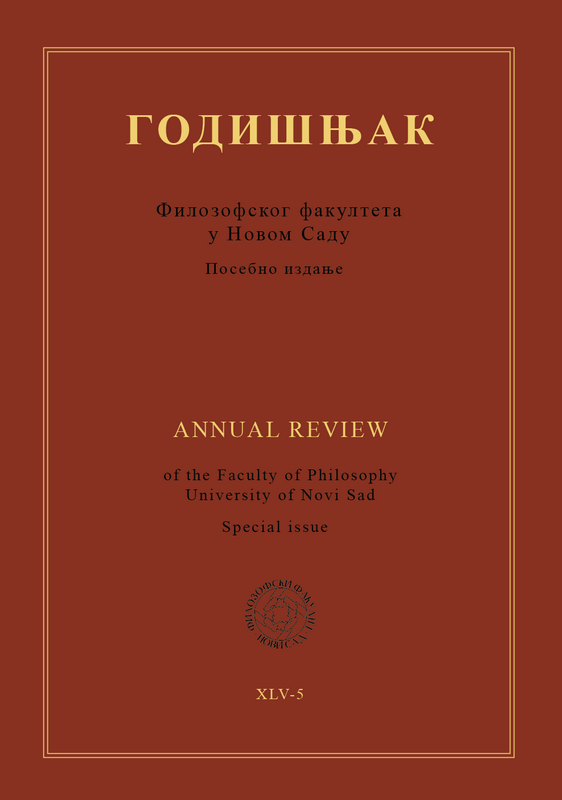THE USE OF METADISCOURSE MARKERS IN ESSAYS WRITTEN BY ESP UNIVERSITY STUDENTS
Main Article Content
Abstract
The study deals with metadiscourse markers employed in the essays written by ESP university students of mechanical engineering. The aim was to investigate the frequency of use of metadiscourse markers and to determine their types according to Hyland’s (2005) taxonomy. The corpus consisted of 100 essays dealing with two topics related to mechanical engineering. The research findings indicate that students used interactional metadiscourse categories to a significantly higher extent than interactive metadiscourse categories. The most used markers overall were transitions, followed by engagement markers and hedges. This suggests that students tried to capture the attention of their readers and make them participate in the discussion. Still, some markers were misused or overused, which implies that students need more instruction in the adequate use of markers. It can be concluded that adding explicit instruction in the use of metadiscourse markers to the ESP university curriculum would increase the level of students’ pragmatic competence so as to help them avoid pragmatic failures in writing.
Downloads
Article Details
References
Aull, L. L.Lancaster, Z. (2014). Linguistic markers of stance in early and advanced academic writing: A corpus-based comparison. Written Communication, 31(2), 151–183.
Blagojević, S. (2008). Metadiskurs u akademskom diskursu. Niš: Filozofski fakultet.
Cheng, X.Steffensen, M. S. (1996). Metadiscourse: A technique for improving student writing. Research in the Teaching of English, 30(2), 149–181.
Blagojević, S. N. (2010). Upotreba eksplicitnih jezičkih sredstava u cilju postizanja persuazivnosti u akademskom diskursu. Radovi Filozofskog Fakulteta, 12(1), 239–251.
Crismore, A.Markkanen, R. & Steffensen, M. S. (1993). Metadiscourse in persuasive writing: A study of texts written by American and Finnish university students. Written communication, 10(1), 39–71.
Crompton, P. (2012). Characterising Hedging in Undergraduate Essays by Middle Eastern Students. The Asian ESP Journal, 8(2), 55–78.
Fraser, B. (2010). Pragmatic competence: The case of hedging. In: Kaltenböck, G.–Mihatsch, W. & Schneider, S. (eds.) (2010). New approaches to hedging. Bingley: Emerald. 15–34.
Harris, Z. S. (1959). The transformational model of language structure. Anthropological Linguistics, 1(1), 27–29.
Hauranen, A. (1993). Contrastive ESP Rhetoric: Metatext in Finnish-English Economics Texts. English for Specific Purposes, 12, 3–22.
Ho, V.Li, C. (2018). The use of metadiscourse and persuasion: An analysis of first year university students’ timed argumentative essays. Journal of English for Academic Purposes, 33, 53–68.
Hyland, K. (1998). Persuasion and context: The pragmatics of academic metadiscourse. Journal of Pragmatics, 30(4), 437–455.
Hyland, K. (2000). Hedges, boosters and lexical invisibility: noticing modifiers in academic texts. Language Awareness, 9(4), 179–197.
Hyland, K. (2001). Humble servants of the discipline? Self-mention in research articles. English for Specific Purposes, 20(3), 207–226.
Hyland, K. (2004). Disciplinary interactions: Metadiscourse in L2 postgraduate writing. Journal of Second Language Writing, 13, 133–151.
Hyland, K. (2005). Metadiscourse: Exploring Interaction in Writing. London, New York: Continuum.
Hyland, K. (2006). English for academic purposes: An advanced resource book. London: Routledge.
Hyland, K. (2017). Metadiscourse: What is it and where is it going? Journal of Pragmatics, 113, 16–29.http://doi.org/10.1016/j.pragma.2017.03.007
Hyland, K.–Tse, P. (2004). Metadiscourse in academic writing: A Reappraisal. Applied Linguistics, 25(2), 156–177.
Intaraprawat, P.Steffensen, M. (1995). The use of metadiscourse in good and poor ESL essays. Journal of Second Language Writing, 4(3), 253–272.
Kobayashi, Y. (2016). Investigating Metadiscourse Markers in Asian Englishes: A Corpus-Based Approach. Language in Focus, 2(1), 19–35.
Lee, J. J.Deakin, L. (2016). Interactions in L1 and L2 undergraduate student writing: Interactional metadiscourse in successful and less-successful argumentative essays. Journal of Second Language Writing, 33, 21–34.
Lee, J.Subtirelu, N. (2015). Metadiscourse in the classroom: A comparative analysis of EAP lessons and university lectures. English for Specific Purposes, 37(1), 52–62.
Li, T.Wharton, S. (2012). Metadiscourse repertoire of L1 Mandarin undergraduates writing in English: A cross-contextual, cross-disciplinary study. Journal of English for Academic Purposes, 11(4), 345–356.
Meyer, B. (1975). The Organization of Prose and its Effects on Memory. Amsterdam: North-Holland.
Rossiter, C. M. (1974). Instruction in metacommunication. Central States Speech Journal, 25(1), 36–42.
Schiffrin, D. (1980). Meta-talk: Organisational and evaluative brackets in discourse. Sociological Inquiry: Language and Social Interaction, 50, 199–236.
Steffensen, M. S.Cheng, X. (1996). Metadiscourse and Text Pragmatics: How Students Write After Learning about Metadiscourse. Pragmatics and Language Learning, 7, 1–18.
Vande Kopple, W. (1985). Some exploratory discourse on metadiscourse. College Composition and Communication, 36, 82–93.
Vande Kopple, W. (2002). Metadiscourse, discourse, and issues in composition and rhetoric. In: Barton, E.–Stygall, G. (eds.) (2002). Discourse Studies in Composition. Cresskill, NJ: Hampton Press. 91–113.
Vande Kopple, W. (2012). The importance of studying metadiscourse. Applied Research in English, 1(2), 37–44.




